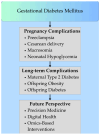From Molecular Insights to Clinical Management of Gestational Diabetes Mellitus-A Narrative Review
- PMID: 40943638
- PMCID: PMC12429770
- DOI: 10.3390/ijms26178719
From Molecular Insights to Clinical Management of Gestational Diabetes Mellitus-A Narrative Review
Abstract
Gestational diabetes mellitus (GDM) is one of the most common metabolic complications during pregnancy, affecting up to 14% of pregnancies globally. GDM is characterized by glucose intolerance that arises or is first identified during pregnancy and is linked to significant short- and long-term adverse outcomes for both mothers and their offspring. The pathophysiology of GDM involves more than maternal insulin resistance and β-cell dysfunction. It is influenced by complex interactions among placental hormones, adipokines, inflammatory mediators, and oxidative stress pathways. Additionally, placental-derived exosomes and metabolomic signatures have emerged as promising biomarkers for early prediction and monitoring of the disease. Despite advancements in clinical diagnosis and management, including lifestyle interventions and pharmacological treatments, current strategies are still inadequate to prevent complications for both mothers and newborns entirely. Recent molecular insights into GDM development have been explored, along with emerging biomarkers and potential therapies. This synthesis also considers prospects for precision medicine strategies that could significantly improve GDM management. The urgent need for improved prevention and treatment of GDM is evident. A deeper understanding of the molecular foundations of GDM is essential and urgent, as it may enhance clinical outcomes and provide opportunities for early prevention of intergenerational metabolic disease risk.
Keywords: adipokines; epigenetics; gestational diabetes mellitus; insulin resistance; placental biomarkers.
Conflict of interest statement
The authors declare no conflicts of interest.
Figures



References
-
- Torres-Torres J., Monroy-Muñoz I.E., Perez-Duran J., Solis-Paredes J.M., Camacho-Martinez Z.A., Baca D., Espino-y-Sosa S., Martinez-Portilla R., Rojas-Zepeda L., Borboa-Olivares H., et al. Cellular and Molecular Pathophysiology of Gestational Diabetes. Int. J. Mol. Sci. 2024;25:11641. doi: 10.3390/ijms252111641. - DOI - PMC - PubMed
-
- Metzger B.E., Gabbe S.G., Persson B., Lowe L.P., Dyer A.R., Oats J.J.N., Buchanan T.A. International Association of Diabetes and Pregnancy Study Groups Recommendations on the Diagnosis and Classification of Hyperglycemia in Pregnancy: Response to Weinert. Diabetes Care. 2010;33:e98. doi: 10.2337/dc10-0719. - DOI - PMC - PubMed
-
- Alberti K.G.M.M., Zimmet P.Z. Definition, diagnosis and classification of diabetes mellitus and its complications. Part 1: Diagnosis and classification of diabetes mellitus. Provisional report of a WHO Consultation. Diabet. Med. 1998;15:539–553. doi: 10.1002/(SICI)1096-9136(199807)15:7<539::AID-DIA668>3.0.CO;2-S. - DOI - PubMed
Publication types
MeSH terms
Substances
LinkOut - more resources
Full Text Sources

